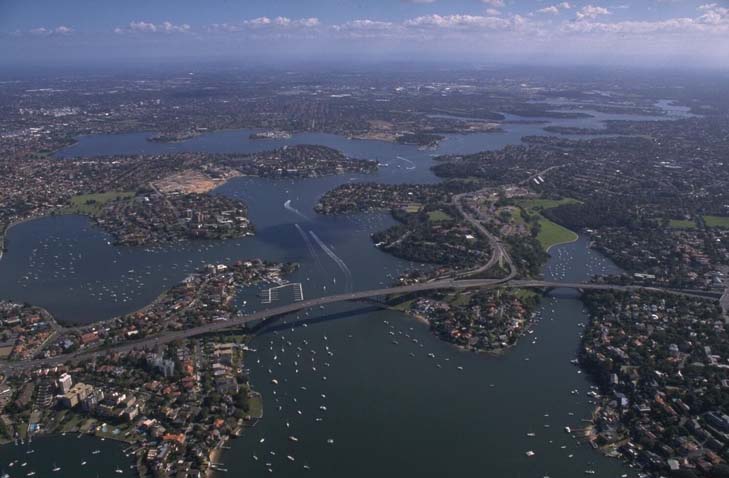Parramatta River is situated within the western section of the Sydney Metropolitan region of New South Wales. This estuary is classed as a drowned valley and is the largest tributary of Sydney Harbour.
Of all of Australia’s rivers, the Parramatta River has the longest history of European colonisation as it was home to the second settlement in 1788. Today around 750,000 people live within this catchment.
The Parramatta River Catchment Group (PRCG) is an alliance of local and state government agencies and community groups that are working on the mission to make the Parramatta River swimmable by 2025. As part of the 10-step Masterplan, new swimming sites are being created and monitoring programs established to assess recreational water quality in the Parramatta River. Recreational water quality and ecological health are different values in a waterway and are assessed using different monitoring programs. For more information on the Parramatta River Masterplan and the monitoring programs carried out by the PRCG visit the Our Living River website.
Water quality report card
As part of our water quality monitoring program we assess the water quality and ecosystem health of an estuary using a range of relevant indicators. We sample a subset of the estuaries located between Taree and Wollongong every 3 years. The most recent sampling in the Cooks River was completed over the 2019–20 summer, when 2 sites were sampled on a monthly basis.
Our sampling and sampling done by the Parramatta River Catchment Group (PRCG) assess the status of 2 distinct values in the river at different locations:
- We assess trends in ecological health of the Parramatta River estuary between Parramatta weir and Wentworth Point. The section of the river we sample for ecological health is considered unsuitable for swimming.
- The PRCG Microbial Monitoring Program measures trends in recreational health at existing and planned swimming sites in other parts of the river. Background research conducted by the PRCG, which involved scientific studies, risk assessments and community consultations, helped determine possible swimming spots in the Parramatta River. Some spots were considered not suitable.
This report card represents 2 water quality indicators that we routinely measure: the amount of algae present and water clarity. Low levels of these 2 indicators equate with good water quality.
Algae
Water clarity
Overall grade
The report card shows the condition of the estuary was poor with:
- algae abundance graded very poor (E)
- water clarity graded fair (C)
- overall estuary health graded poor (D).
Grades for algae, water clarity and overall are represented as:
- A – excellent
- B – good
- C – fair
- D – poor
- E – very poor.
Go to estuary report cards to find out what each grade means, read our sampling, data analysis and reporting protocols, and find out how we calculate these grades.
We have monitored water quality in the Parramatta River since 2007. This table shows the water quality grades for this estuary over that time.
| Year | Algae | Water clarity | Overall grade |
|---|---|---|---|
| 2007–08 | D | B | C |
| 2010–11 | E | D | E |
| 2013–14 | E | C | D |
| 2016–17 | D | B | C |
Physical characteristics
| Estuary type | Drowned valley |
|---|---|
| Latitude (ºS) | –33.84 |
| Longitude (ºE) | 151.19 |
| Catchment area (km2) | 252.4 |
| Estuary area (km2) | 13.7 |
| Estuary volume (ML) | 69,700 |
| Average depth (m) | 5.1 |
Tidal exchange volume
Tidal exchange volume or tidal prism data is available for this estuary. This tidal prism was measured in 1992.
| Tide state | Flow (ML) | Local tidal range (m) | Sydney Harbour tidal range (m) |
|---|---|---|---|
| Ebb flow | 27,650 | 1.62 | 1.56 |
| Flood flow | 23,770 | 1.57 | 1.55 |
Notes: km2 = square kilometres; m = metres; m3 = cubic metres; ML = megalitres.
Water depth and survey data
Bathymetric and coastal topography data for this estuary are available in our data portal.
Land use
The Parramatta River catchment has been impacted by settlers since 1788. About 10% of the catchment remains forested today. Urban development is the dominant land use, whereas cleared land for agriculture, horticulture and industrial uses account for small fractions of land use.
National and marine parks
- Newington Nature Reserve is the largest conservation area in this catchment.
- This estuary does not flow into a marine park.
Citizen science project
- The Parramatta River Catchment Group website provides links to various citizen science projects in and around the Parramatta River.
Community involvement
- Parramatta River Catchment Group is an alliance of councils, government agencies and community groups working to improve the health of the river. They support community members to get involved in improving the environment around the Parramatta River.
- Greater Sydney Landcare Network is a community organisation and umbrella group for a host of Landcare organisations in the region. They have a number of projects listed on their website and support volunteers to get involved in work to protect, restore and improve the natural environment of Greater Sydney.

Aerial view of Parramatta River estuary.
Local government management
Local councils manage estuaries within their area unless the estuary is attached to a marine park.
The Parramatta River spans the local government areas of Blacktown, Burwood, Canada Bay, Canterbury Bankstown, Cumberland, Hunters Hill, the Inner West, Parramatta, Ryde, Strathfield and The Hills Shire.
Threatened species
The Parramatta River estuary supports habitat for an endangered population of the long-nosed bandicoot, particularly around Canada Bay.
Read more about the biodiversity in our estuaries.